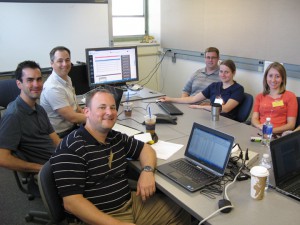Whole genome sequencing has the potential to revolutionize influenza vaccines. It also generates lots and lots of data.

Around the table from bottom left are Nick Beckloff (GenoLogics), Thomas Stark (CDC Influenza Division), Rob Hall (GenoLogics), Rich Griesser and Tonya Danz (WSLH) and Stephanie Chester (APHL).
In late July, representatives from the Centers for Disease Control and Prevention (CDC) and GenoLogics trained Wisconsin State Laboratory of Hygiene (WSLH) scientists on the CLARITY laboratory information management system (LIMS).
CLARITY is the LIMS used as part of a 3-year CDC-funded project at the WSLH to pilot Next Generation whole genome sequencing of influenza viruses submitted for surveillance from Wisconsin and other states.
The CLARITY LIMS will maintain and monitor quality assurance throughout the whole genome sequencing and data transfer process to CDC. GenoLogics developed the CLARITY LIMS.
Genetic characterization of influenza viruses is important both for monitoring genetic drift (how the virus may be changing) and for selecting the virus strains to include in influenza vaccines. Next generation sequencing of influenza viruses in state public health laboratories could potentially shave months off the vaccine development process.
The WSLH is the first state public health laboratory in the country to collaborate with the CDC on this cutting-edge technology. The WSLH has been 1 of 3 CDC-designated Influenza Reference Public Health Labs since 2009.
The Association of Public Health Laboratories (APHL) is coordinating and facilitating the pilot project for CDC.
More Information: APHL/CDC Pilot Trumps WGS File Size for Fast Exchange of Flu Data
